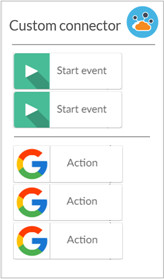Build your first Xtension
With the Nintex Xtensions framework, you can create Xtensions A set of instructions for Nintex Automation Cloud to use third-party API functionality with Nintex workflows. An Xtension may include workflow actions, start events, forms or file control. to extend Nintex Automation Cloud beyond the many high-value connectors Nintex provides out of the box. By writing and uploading an OpenAPI Specification A standard, language-agnostic description of RESTful APIs that can be read by both humans and machines. Formerly known as Swagger., you can integrate any service or data source with a RESTful Representational State Transfer: a style of software architecture that separates state and functionality into distributed resources, with each resource uniquely addressable, typically using HTTP commands. RESTful applications are usually stateless and support caching. API A programming interface that defines how software can be interacted with by other software. into your workflow. The advantage of using the OpenAPI Specification to define Xtensionis there’s no bus, no middleware and no executing code: you can instantly generate a user interface for your integration inside the Nintex Automation Cloud designer.

An Xtension is a set of instructions that allows Nintex Automation Cloud to communicate with an external API. Each API requires its own Xtension specific to that API, which defines how that API can be used within your workflow, including:
- Workflow actions
- Workflow start events
- File handling operations
An Xtension can contain as many actions, start events, and file handling operations as you need.
Note: Creating start events with Xtensions is not yet available.
Xtensions are used only in Nintex Automation Cloud. If you do not have a Nintex Automation Cloud tenancy, more information and a request for a 30 day trial is available here: http://www.nintex.com/workflow-platform/nintex-workflow-cloud.
What is the OpenAPI Specification?
The OpenAPI Specification (OAS), formerly known as the Swagger specification, is an open standard for writing API A programming interface that defines how software can be interacted with by other software. definitions in a way that is easily readable by both humans and software. Because of its readability, extensibility and ease of editing, OpenAPI Specification is rapidly being adopted as the standard for API description across the industry.
Nintex Xtensions uses the OpenAPI Specification to integrate apps, services and data sources into workflows to make integrating with Nintex as fast and simple a process as possible.
OpenAPI Specifications for Nintex Xtensions must be written in JSON JavaScript Object Notation: a data format based on JavaScript that is commonly used for API request parameters and responses.. We recommend Xtensions are written by developers or users with an in-depth understanding of APIs.
Note: Nintex Xtensions currently supports OpenAPI Specification 2.0 only.
Looking to upload a product or service's published OpenAPI Specification? See Import a third-party specification.
Tools and resources you can use
Several tools exist to help create and test your OpenAPI Specifications.
The Nintex OpenAPI Specification quick reference file
You can quickly build an OpenAPI Specification by copying and pasting sections from our quick reference file. Sample code is supplied for parameters, authentication methods, Nintex Specification Extensions and other functionality.
OpenAPI Specification quick reference
The Swagger.io editor
The Swagger.io editor allows you to create, edit and validate OpenAPI Specifications, and view the resulting API in an interactive format. The interactive format allows you to test that your API operations have been described correctly, and respond as expected. You can also quickly convert from YAML A subset of the human-readable JSON format that uses indentations instead of braces and brackets. YAML can be readily converted into JSON. Nintex Xtensions supports JSON only. to JSON format for use in Nintex Xtensions.
Studio.Restlet
The Studio.Restlet editor allows you to build an OpenAPI Specification by filling in fields to create operations A single request to a third-party API. Operations often become actions in the workflow designer. and responses The return from a third-party API after a request has been made by the client.. Because it is all created with forms, you never have to read the underlying code, allowing people who are unfamiliar with JSON to create and edit their own OpenAPI Specifications.
Open the Studio.Restlet editor.
References
See the Nintex Xtensions Glossary for explanations of terms used in this documentation.
You can also refer to the OpenAPI Specification definition for more information.